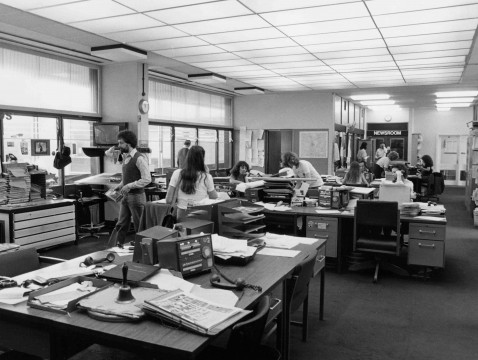During my time in the newsroom all material – except for a few ‘features’ was shot on reversal commag stock. The main problem with commag stock was, of course, the separation of the gate and the recording head, meaning that cutting the picture in the right place was wrong for the sound and vice-versa, hence the need to transfer the sound to sepmag stock (16mm magnetic tape, but it was perforated like 16mm.). If time didn’t allow for the transfer, then the cut mismatch had to be accommodated by either inserting a noddy (or the next actual reporter’s question preceeded by a pontifical (leading) noddy, or any one of a number of other technical fudges!). Or else it needed dubbing in studio 9 where we covered the bumps with suitable audio (commentary, SFX, music etc.) recorded onto sepmag stock in the TK machine, or occasionally dubbing it live if a last-minute network insert run live from London (more adrenaline than on a battle-field!). Not forgetting – as occasionally happened – to gently remind the TK operator to ‘pull it up 3 frames’ before TX.
I don’t believe edited sepmag was ever laid back to the commag – apart from anything else, the resultant audio would have ‘bumped’ over the edits. Why would you bother when the commag track was about a 10th the size of the sepmag? Having had the opportunity to see other regional news mags, and how they coped with commag and all its attendant problems (usually live reporter v/o in the studio + live grams) I think studio 9 was an elegant and efficient solution, no matter how much some of the ‘proper’ dubbing mixers looked down their collective noses at us! The features, and the opt-outs were usually shot on either reversal (with the commag track not used, or used as either a guide track or occasionally a wild track) with sound on 1/4″ recorded on a Nagra or mute colour neg + 1/4″. What a faffy world it was before video/u-matic/Beta/digibeta, but I count dubbing shifts in studio 9 as some of my happiest times in Pebble Mill.
Paul Freeman
Peter Poole, left the following comment on the Pebble Mill Facebook Group: ‘Hi Paul, thanks for an interesting blog. I probably complained about Studio 9. You had limited facilities and time pressure. And looking back on it I think you did a good job. I remember station assistants playing sound effects discs live in Studio B to cover mute film. Norwich still did live commentary even when U-matic tape was in use.’
